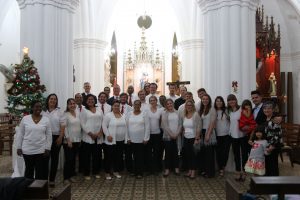Building Cultural Bridges through Music
A Montana Choir’s Trip to Cuba
Kirk Aamot, Associate Professor of Music at Montana State University
The human desire to connect with others is universal, profound and enduring. Unfortunately, the obstacles that keep us apart are ubiquitous, deep and persistent. Music has the power to transcend profound cultural differences and help to create community among peoples of different backgrounds. A shared love and appreciation for music can be fertile ground for forming deep and lasting friendships.
On a recent choral collaboration, fourteen college students from Bozeman, Montana and twelve choral singers from Havana, Cuba formed a beautiful bond of friendship through their shared love for choral music. However, in the first rehearsal, it was quickly apparent that our different approaches to making music could be one of the obstacles that would create separation and keep us apart.
Music can transcend cultural differences and help to create community, but initially our approach to music was one of the obstacles that created separation between us.

Members of the “Montanans” from MSU traveling to their concert venue in Havana. Photo credit: Hailey Maurer Photography
In November 2018 our choir was honoured to receive an invitation from Juan García Rodriguez, Archbishop of Havana, to perform a Christmas concert at the Havana Cathedral as part of an eight-day visit to Cuba. Royce Smith, Dean of the College of Arts and Architecture at Montana State University, helped to secure this invitation. Performing in the Cathedral is a distinct honour. For this event, and three other concerts in Havana, our choir joined with Artes de Cortes, the parish choir of Nuestra Señora del Carmen directed by Silvia Ponce. Sylvia and I agreed on music our choirs would sing together at the end of each concert. Once we gathered in Havana and began rehearsing, however, we discovered that we would need to reconcile our different approaches in rehearsal in order to unite as one ensemble.
Our singers had significantly different approaches to rehearsing music. For the students from Montana, music is first and foremost their discipline. Their first priority is to reproduce the notated music faithfully. They love to sing and they always perform with sincere expression, but their first goal is musical accuracy. Also, the majority of their performances are out of context. They study music from various cultures and time periods and re-create that music in a modern concert setting. Finally, their evaluation of their own performance is more objective than subjective. It isn’t that they are dispassionate about the music they are performing, but they have learned to judge their performances on whether they sang the music accurately and in the appropriate style. If they fail to do those two things, ultimately they aren’t satisfied with their performance.
We observed that, for the Cuban singers, music is first and foremost a means of being in community with one another and with the people who hear them sing. They love being together and singing together. They love sharing their music with their audiences. Most often the Cuban choir learned their music by listening to each other and sharing musical ideas. They sang parts for each other. Sylvia would have a few copies of the music on hand, but most of the singers would learn by listening and repeating. They often adapted the music as they rehearsed it. Whether practising or performing, they communed around the music. As they rehearsed, a strong sense of unity was created around their common purpose. As opposed to the college students, the Cuban choir always performed music in context. They learned their music in order to share it during worship services. They felt successful when they shared in the learning process with each other and created beautiful music in worship settings that inspired the congregation.
In our planning discussions, Sylvia and I were aware of the different ways our choirs approached rehearsal; however, we didn’t anticipate how deeply these modes of learning were ingrained in our singers or how long it would take for each group to overcome its paradigm so that they could sing together. I didn’t realise how my students depended on “correctness” for affirmation and a sense of accomplishment and how uncomfortable it would be for them to change their perspective. Sylvia didn’t fully realize how important it was to her singers that the students learn the music from them without relying primarily on their notated scores.
“The music is not on that sheet of paper you are looking at.” That statement by Sylvia began the building of a beautiful bridge of understanding between the two groups of singers.
The difference in musical approach was palpable the very first evening the singers met. We arrived at the church early in order to have some rehearsal time on our own before the Cuban choir arrived. We began working on the piece we would sing with Sylvia’s choir, each student with a copy of the score and pencil in hand, diligently marking their music as we worked. When members of Artes de Cortes arrived and the joint rehearsal began, the students from Montana struggled to rehearse alongside their Cuban counterparts. Not all of the Cuban singers used music. Also, within each section of the Cuban choir there were small discrepancies between the singers as to how the music should go. At some cadential points singers in the same section would go to different notes in the final chord. Some singers added small appoggiaturas to the melody line and others didn’t. Occasionally, one of the basses would sing the melody an octave below the sopranos. These discrepancies were an accepted part of their music-making, but it was difficult for the students from Montana to understand that that the Cuban singers accepted these variations and didn’t always try to reconcile them. For Sylvia and her choir, creating community and worshipping through music was more important than uniformity. When Sylvia sensed how important it was for her singers to feel connected to their guests and that my students’ printed scores were getting in the way, she made a comment that eventually led to our coming together as one ensemble. She asked for everyone’s attention and, through an interpreter, told the students from Montana, “the music is not on that piece of paper that you are looking at”. That statement began the building of a beautiful bridge of understanding between the two groups of singers.
Up to this point in the rehearsal, my students were trying to reconcile the notated music with what they were hearing from the Cuban singers. Sylvia’s singers could sense that their new friends were confused, and they seemed to be wondering why the students kept looking at the music rather than at them. The members of Artes de Cortes wanted to teach the students how they performed the music, regardless of whether it matched the notation. In order to reconcile the different modes of rehearsal, the students had to stop regarding the music as the authority and cooperate with the Cuban singers. Once they did this, the first section of the bridge was in place.
A natural and important shift took place when one by one the students changed their focus from singing the music correctly according to the notated score to singing together with their Cuban friends.
Slowly students started to shift their focus from the music to the Cuban choir members. One by one they put down their music and joined their voices with the Cuban singers. They listened, they repeated phrases, they smiled, laughed and began to form a singing community. Members of the Cuban choir reached out and touched the arms and shoulders of the students as they sang the parts for them, emphasising those turns of phrase that were different from the notated score. The students’ willingness to learn greatly encouraged the Cuban singers. Now that they had the students’ full attention and the printed scores were set aside, they began to make music together. Soon the students had their parts learned, to the delight of the Cuban choir. The sounds of the students’ voices bolstered the Cuban choir’s enthusiasm and passion; Sylvia and I thoroughly enjoyed the beautiful concord that was created.
By the end of our time together, through music, the students and members of Artes de Cortes did more than unite as an ensemble; they began to form a true bond of friendship. Our differing rehearsal priorities were initially barriers, but in the end singing together proved to be a medium in which we could form a community. Resolving the difference in our rehearsal methodology required that we listen to each other, respect our differences, and make cooperation the most important goal. If each group had insisted that its choral culture was the right approach and refused to accommodate the other, we would have remained separate groups.
“Artists are the ambassadors for our culture” – Digna Guerra.
Artists play a crucial role in promoting cultural understanding. For the students from Montana and the members of Artes de Cortes, a shared love of singing was strong enough to bridge cultural differences and to reconcile our different approaches to the choral art to create a lasting bond of friendship. When the college students first met their Cuban friends, there were many significant differences between the two groups of singers. The students were a generation younger than the volunteer church musicians. They lived in Montana, a state three times as large as the country of Cuba with only one tenth of the island’s inhabitants. No one in our group had ever been to Cuba and not one member of the Havana-based choir had ever left the island. Yet despite these obstacles, the bridge built between these groups through choral music will last a lifetime. Our art gives us an instant connection that allows for open and honest sharing, but differences in our approach to artistic expression can be a potential barrier. In our first rehearsal, after we agreed on how we would approach learning the music, everyone in the room united around the goal of artistic expression. Our love for music and the beauty of the music itself compelled us to cooperate and to enter into each other’s world. We discovered that our common love for music was much stronger than the differences that initially divided us.

“Beautiful Concord”: the singers from Montana State University and members of Artes e Cortes. Photo credit: Hailey Maurer Photography
 Kirk Aamot is Associate Professor of Music at Montana State University in Bozeman, MT, where he conducts the University Chorale and Montanans while teaching choral methods and choral conducting. His editions of choral music are published by Hal Leonard, Kjos Music, Santa Barbara and Alliance Music Press and his reviews of choral music performance practice and teaching philosophy have been published in regional, national and international publications of the American Choral Directors Association. His conducting and teaching mentors include Anton Armstrong, Kathy Romey, Lawrence Kaptein and Joan Catoni Conlon. Dr Aamot is a board member of the National Collegiate Choral Organization as well as a member of the International Federation of Choral Musicians, the National Association for Music Education and the American Choral Directors Association. Email: kaamot@montana.edu
Kirk Aamot is Associate Professor of Music at Montana State University in Bozeman, MT, where he conducts the University Chorale and Montanans while teaching choral methods and choral conducting. His editions of choral music are published by Hal Leonard, Kjos Music, Santa Barbara and Alliance Music Press and his reviews of choral music performance practice and teaching philosophy have been published in regional, national and international publications of the American Choral Directors Association. His conducting and teaching mentors include Anton Armstrong, Kathy Romey, Lawrence Kaptein and Joan Catoni Conlon. Dr Aamot is a board member of the National Collegiate Choral Organization as well as a member of the International Federation of Choral Musicians, the National Association for Music Education and the American Choral Directors Association. Email: kaamot@montana.edu
Edited by Katie Sykes, UK

